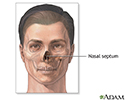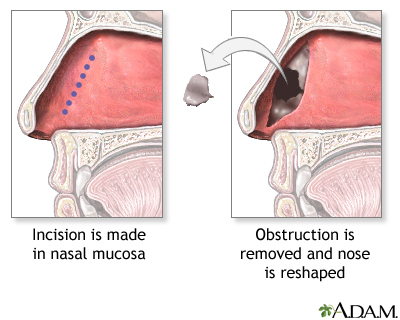Septoplasty
Nasal septum repair
Septoplasty is surgery performed to correct any problems in the nasal septum, the structure inside the nose that separates the nose into two chambers.
Description
Most people receive general anesthesia for septoplasty. This will make you asleep and pain-free. Some people have the surgery under local anesthesia, which numbs the area to block pain. You will stay awake if you have local anesthesia. Surgery takes about 1 to 1 ½ hours. Most people go home the same day.
General anesthesia
General anesthesia is treatment with certain medicines that puts you into a deep sleep so you do not feel pain during surgery. After you receive the...
To do the procedure:
The surgeon makes a cut inside the wall on one side of your nose.
-
The
mucous membrane
that covers the wall is elevated.
Mucous membrane
Mucosa is moist tissue that lines certain parts of the inside of your body. It is in your: NoseMouthLungsUrinary and digestive tracts Glands in this...
 ImageRead Article Now Book Mark Article
ImageRead Article Now Book Mark Article - Cartilage or bone that is causing the blockage in the area is moved, repositioned or taken out.
- The mucous membrane is put back in place. The membrane will be held in place by stitches, splints, or packing material.
Why the Procedure Is Performed
The main reasons for this surgery are:
- To repair a crooked, bent, or deformed nasal septum that blocks the airway in the nose. People with this condition very often breathe through their mouth and may be more likely to get nasal or sinus infections.
-
To treat
nosebleeds
that cannot be controlled.
Nosebleeds
A nosebleed is loss of blood from the tissue lining the nose. Bleeding most often occurs in 1 nostril only.
 ImageRead Article Now Book Mark Article
ImageRead Article Now Book Mark Article
Risks
Risks for any surgery are:
- Allergic reactions to medicines
-
Breathing problems
Breathing problems
Breathing difficulty may involve:Difficult breathingUncomfortable breathingFeeling like you are not getting enough air
 ImageRead Article Now Book Mark Article
ImageRead Article Now Book Mark Article - Heart problems
-
Bleeding
Bleeding
Bleeding is the loss of blood. Bleeding may be:Inside the body (internally) Outside the body (externally)Bleeding may occur:Inside the body when blo...
 ImageRead Article Now Book Mark Article
ImageRead Article Now Book Mark Article - Infection
Risks for this surgery are:
- Return of the nasal blockage. This could require another surgery.
- Scarring
- A perforation, or hole, in the septum
- Changes in skin sensation
- Unevenness in the appearance of the nose
- Skin discoloration
Before the Procedure
Before the procedure:
- You will meet with the doctor who will give you anesthesia during the surgery.
- You go over your medical history to help the doctor decide the best type of anesthesia.
- Be sure you tell your health care provider about any medicines you take, even drugs, supplements, or herbs you bought without a prescription. Also tell your doctor if you have any allergies or if you have a history of bleeding problems.
- You may need to stop taking any drugs that make it hard for your blood to clot 2 weeks before your surgery, including aspirin, ibuprofen (Advil, Motrin), naproxen (Aleve, Naprosyn), and some herbal supplements.
- You may be asked to stop eating and drinking after midnight the night before the procedure.
After the Procedure
After the procedure:
- You will most likely go home on the same day as surgery.
- After surgery, both sides of your nose may be packed (stuffed with cotton or spongy materials). This helps prevent nosebleeds.
- Most of the time this packing is removed 24 to 36 hours after surgery.
- You may have swelling or drainage for a few days after the surgery.
Outlook (Prognosis)
Most septoplasty procedures are able to straighten the septum. Breathing often improves.
References
Kridel RWH, Strum-O'Brien A. The nasal septum. In: Flint PW, Haughey BH, Lund LJ, et al, eds. Cummings Otolaryngology: Head & Neck Surgery . 6th ed. Philadelphia, PA:Elsevier Mosby; 2015:chap 32.
Review Date: 2/3/2015
Reviewed By: Alan Lipkin, MD, otolaryngologist, private practice, Denver, CO. Review provided by VeriMed Healthcare Network. Also reviewed by David Zieve, MD, MHA, Isla Ogilvie, PhD, and the A.D.A.M. Editorial team.





